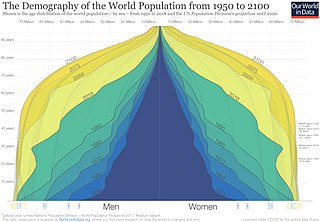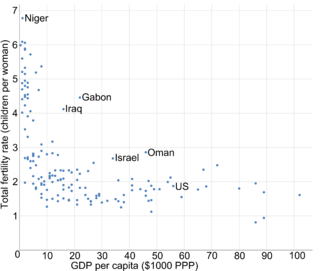Related Research Articles

Demography, also known as Demographics, is the statistical study of populations, especially human beings.
In demography, demographic transition is a phenomenon and theory which refers to the historical shift from high birth rates and high death rates in societies with minimal technology, education and economic development, to low birth rates and low death rates in societies with advanced technology, education and economic development, as well as the stages between these two scenarios. In economic growth, the demographic transition has swept the world over the past two centuries, and the unprecedented population growth of the post-Malthusian period was reversed, reducing birth rates and population growth significantly in all regions of the world, and enabling economies to translate more of the gains of factor accumulation and technological progress into per capita income growth. The demographic transition strengthens economic growth process by three changes: (i) reduced dilution of capital and land stock, (ii) increased investment in human capital, and (iii) increased size of the labor force relative to the total population and changed age population distribution. Although this shift has occurred in many industrialized countries, the theory and model are frequently imprecise when applied to individual countries due to specific social, political and economic factors affecting particular populations.
Major General Frederick Henry Osborn CBE was an American philanthropist, military leader, and eugenicist. He was a founder of several organizations and played a central part in reorienting eugenics in the years following World War II away from the race- and class-consciousness of earlier periods. The American Philosophical Society considers him to have been "the respectable face of eugenic research in the post-war period."
Kingsley Davis was an internationally recognized American sociologist and demographer. He was identified by the American Philosophical Society as one of the most outstanding social scientists of the twentieth century, and was a Hoover Institution senior research fellow.
Natural fertility is the fertility that exists without birth control. The control is the number of children birthed to the parents and is modified as the number of children reaches the maximum. Natural fertility tends to decrease as a society modernizes. Women in a pre-modernized society typically have given birth to a large number of children by the time they are 50 years old, while women in post-modernized society only bear a small number by the same age. However, during modernization natural fertility rises, before family planning is practiced.
Ansley Johnson Coale, was one of America's foremost demographers. A native to Baltimore, Maryland, he earned his Bachelor of Arts in 1939, his Master of Arts in 1941, and his Ph.D. in 1947, all at Princeton University. A long-term director of the Office of Population Research at Princeton, Coale was especially influential for his work on the demographic transition and for his leadership of the European Fertility Project.
John Charles "Jack" Caldwell was an Australian demographer. He researched extensively in Africa, South Asia and Southeast Asia since 1959, particularly the fields of fertility transition and health transition. Caldwell had a significant impact on demographic teaching, research and policy formulation.

Income and fertility is the association between monetary gain on one hand, and the tendency to produce offspring on the other. There is generally an inverse correlation between income and the total fertility rate within and between nations. The higher the degree of education and GDP per capita of a human population, subpopulation or social stratum, the fewer children are born in any developed country. In a 1974 United Nations population conference in Bucharest, Karan Singh, a former minister of population in India, illustrated this trend by stating "Development is the best contraceptive." In 2015, this thesis was supported by Vogl, T.S., who concluded that increasing the cumulative educational attainment of a generation of parents was by far the most important predictor of the inverse correlation between income and fertility based on a sample of 48 developing countries.

The Office of Population Research (OPR) at Princeton University is the oldest population research center in the United States. Founded in 1936, the OPR is a leading demographic research and training center. Recent research activity has primarily focused on healthcare, social demography, urbanization, and migration. The OPR's research has been cited in numerous articles by the New York Times and the Wall Street Journal.
Historical demography is the quantitative study of human population in the past. It is concerned with population size, with the three basic components of population change, and with population characteristics related to those components, such as marriage, socioeconomic status, and the configuration of families.
Demographic economics or population economics is the application of economic analysis to demography, the study of human populations, including size, growth, density, distribution, and vital statistics.
Charles B. Nam was born in Lynbrook, New York on March 25, 1926, and currently resides in Tallahassee, Florida. He was a Professor of Sociology for 31 years with one of his most important contributions being the Nam-Powers Index measuring occupational status.

Demographically, as in other more recent and thus better documented pre-modern societies, papyrus evidence from Roman Egypt suggests the demographic profile of the Roman Empire had high infant mortality, a low marriage age, and high fertility within marriage. Perhaps half of the Roman subjects died by the age of 5. Of those still alive at age 10, half would die by the age of 50.
Joseph John Spengler was an American economist, statistician, and historian of economic thought. A recipient of the 1951 John Frederick Lewis Award of the American Philosophical Society and the 1981 Distinguished Fellow Award from the History of Economics Society, he was Professor Emeritus of Economics at Duke University at the time of his death.
Karol Józef Krótki, FRSC was a renowned Polish Canadian demographer who, at various times, lived and worked in Poland, the United Kingdom, Sudan, Pakistan, Morocco and Canada. Professor Krotki was elected to the Royal Society of Canada in 1979.

Wolfgang Lutz is an Austrian demographer specializing in demographic analysis and population projection. He founded the Wittgenstein Centre for Demography and Global Human Capital in 2010 – a collaboration between IIASA, the Vienna Institute of Demography (VID) of the Austrian Academy of Sciences, and the WU-Vienna University of Economics and Business. In October 1985 he joined IIASA to lead the World Population Program. He has been director of VID since 2002 as well as a full professor of applied statistics (part-time) at Vienna University since 2008. He also holds the position of professorial research fellow at the Oxford Martin School for 21st Century Studies.
Anatole Romaniuk was a Ukrainian Canadian demographer who contributed to fertility and sterility, African demography, Aboriginal studies, demographic processes, and population forecasting. He played a key role in numerous population censuses, including the first population census in the Democratic Republic of Congo, several censuses in Canada from 1970 through to 1993, and the first census of independent Ukraine (2001).

Irene Barnes Taeuber was an American demographer who worked for the Office of Population Research at Princeton University, where she edited the journal Population Index from 1936 to 1954. Her scholarly work is credited with helping to establish the science of demography.
William Brass was a Scottish demographer. He developed indirect methods for estimating mortality and fertility in populations with inaccurate or incomplete data, often dubbed "Brass methods" after him.

Paul Demeny is a Hungarian demographer and economist known for pioneering the concept of Demeny voting.
References
- 1 2 3 4 Coale, Ansley (Spring 1983). "Frank W. Notestein, 1902-1983". Population Index. 49 (1): 3–12. JSTOR 2737137.
- ↑ Weeks, John (2014). Population, An Introduction to Concepts and Issues. United States: Cengage Learning. p. 82. ISBN 978-1-305-09450-5.
- ↑ "APS Member History". search.amphilsoc.org. Retrieved 2023-03-27.
- ↑ "Frank Wallace Notestein". American Academy of Arts & Sciences. Retrieved 2023-03-27.
- 1 2 Coale, Ansley (2000). Ansley J. Coale: An Autobiography. ISBN 9780871692368.